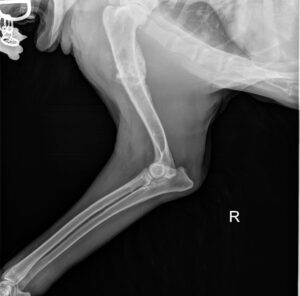
In honor of Pet Cancer Awareness Month, Mount Carmel Animal Hospital shares informative details regarding osteosarcoma in dogs.
Cancer in pets can result from different environmental and genetic factors, and the more pet owners know, the more opportunities they have to take preventative measures to protect their furry companions. In honor of Pet Cancer Awareness Month, Mount Carmel Animal Hospital shares informative details regarding osteosarcoma in dogs.
What is Osteosarcoma?
Osteosarcoma is a painful type of bone cancer that is usually found in the larger bones of a dog. It’s more prevalent in larger breeds, including Dobermans, German Shepherds, Boxers, Rottweilers, and Weimaraners. Osteosarcomas are tumors that occur from abnormal cell production that make and break down bone. The most common bones affected are the limbs, hips, jaws, or pelvis. However, osteosarcoma in dogs can also affect their non-bony tissues, such as the spleen, kidneys, liver, and mammary glands.
Signs and Symptoms
Osteosarcoma in dogs is painful. If your canine has osteosarcoma of the limb, lameness or a distinct swelling might be noted. Your pet might be more lethargic, have a loss of appetite, and be reluctant to play or walk because of pain caused by the tumor on the bone. The most prevalent areas for osteosarcomas in dogs are the ulna or radius between the wrist and the elbow and the tibia/fibula between the ankle and the knee.
Diagnosis
Most canines with osteosarcoma will limp on the affected limb. Swelling is typically noted where the tumor has grown, and the area will be warm due to the extreme inflammation. Your vet will perform X-rays on the areas where osteosarcomas appear. Areas of bone affected by osteosarcoma will look moth-eaten because of bone missing due to the loss of normal bone tissue. A fine needle aspiration obtains a definitive diagnosis if a lesion is suspected. The vet will place a small needle with a syringe and suction sample cells from the lesion on a microscope slide. Histopathology will be performed if amputation is elected.
Treatment
If there is no evidence of metastasis, the primary goal is local tumor control. This usually involves amputating the affected limb. Even though this is unsettling for many dog owners, most dogs do very good after amputation. Surgery is virtually always pursued as long as it’s safe and it provides significant relief from pain.
Chemotherapy is always the best treatment post-surgery to help control osteosarcoma in dogs for as long as possible. Other treatment options might be available, too, including radiation therapy. Fortunately, dogs don’t experience as many side effects from chemo as humans, and their quality of life is improved.
Prognosis
Unfortunately, the long-term prognosis for dogs with osteosarcoma is not good. Without surgical intervention and chemotherapy, the average lifespan after diagnosis is about six months. Osteosarcoma is about quality and not quantity. With amputation and chemotherapy, most dogs enjoy a quality life for about a year and some even live up to two years. Adequate pain control is essential. If your pet is diagnosed with osteosarcoma, a treatment plan will be formulated by your veterinarian to best suit your dog’s needs.
HERE AT MOUNT CARMEL ANIMAL HOSPITAL, WE’LL TREAT YOUR PETS LIKE FAMILY!
Mount Carmel Animal Hospital has been serving the Northern Baltimore/Southern York community for over 30 years and is proud to be an independently operated, small animal practice committed to excellence in veterinary medicine and client service. From grooming to wellness services, along with Canine Life Skills Training Courses, and surgical procedures, we have the expertise that will best serve the needs of you and your pet. Contact us at 410-343-0200 and follow us on Facebook.
